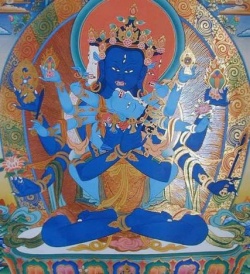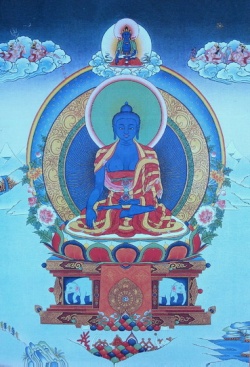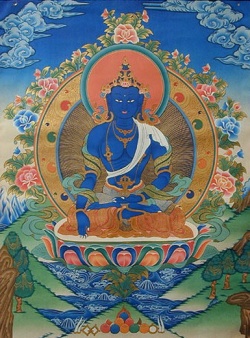Introduction to the Vajra Family
Even though the Body/Mind develops from the inside out, I am starting with the Vajra family as it represents the grossest levels of our existence and ,as we understand the workings of our body and mind, we usually need to clarify the grosser levels before we can even perceive, let alone understand, the subtler levels of our body/mind collections.
Each of the elements that make us up have a basic nature and inherent wisdom. Because each of our body/mind components are connected with an element then each of the components of our Body and Mind also have a underlying, basic wisdom nature. If we express this basic nature correctly then our expression manifests as Wisdom and Compassion, Peace and Joy. If we express this basic nature incorrectly, then our expression becomes confusion, self-isolation, emotional disturbance, and suffering.
As we review the various traits of each of these families, we need to examine ourselves to notice the amount of work we each need to do in order to minimize the appearance of the neuroses of each family. We also need to notice how much work we need to do to increase our ability to perfect the wisdom within each family.
The Vajra family represents the outer levels of our existence. Within this outer level we develop either the understanding of the details of the interconnection of the various components of our world, or we develop the increasing sense of difference and separation.
The Vajra family involves the Form Collection or Skanda and the element of water. Water involves penetrating and connecting. Water represents holding things together. Water represents clarity and purification. This can be seen in how it molds itself to any container and penetrates all nooks and crannies of whatever vessel it finds itself in.
The Vajra Family has the passive energy of Clarity and Penetrating Insight which is similar to the Water element. The active energy is Analyzing, organizing and Resolving which is visible in the Form collection. Vajra family energy is concerned with logic, analysis, structure and organization.
The portion of the body belonging to the Vajra family is the head and brain. It should be noted that from the point of view of Buddhist psychology, the brain represents the secondary mind. The primary mind in buddhism is consciousness, which is located at the heart centre. The brain and secondary mind function for the purpose of analysis and in the storage and processing of information and previous experiences.
The Form Skanda is concerned with connecting and organizing. So the Vajra family involves our Body, Forms and Structures. This includes our analytical thoughts, our speech, and our actions. It also involves all the objects, details, and intricacies of our world. Each form represents a collection of components organized and held together for a specific function. All forms work this way and the biggest example that we have of Form, which we use every day, is our own bodies.
We spend most of our lives preoccupied with the level of Form and with the level of Feelings (which is part of the Ratna family). This is due to the fact that there is a tremendous amount of vividness, detail, solidity and structure in every type of Form that surrounds us. Form helps to provide an anchor and stability to our mind. Mind and Body are often equated to a lame person being carried by a blind man. Without the lame person's eyes and awareness, they would be lost and without the blind person's legs and strength, they would not be able to act on their wishes and go somewhere.
The Wisdom of the Vajra Family is the Wisdom of Intelligence and Analysis. This involves the process of Clear Seeing and Penetrating Analysis. The Vajra family also involves the process of discursive thought as it is concerned with details and logic and structure. This is our ability to organize, analyse and resolve the various portions of our world.
The neuroses of the Vajra family are Anger, Fear, Pessimism, and Superiority. The Intelligence of Vajra Wisdom highlights the differences between portions of our world and the negative aspects of any situation. When we try to resolve, eliminate or avoid these differences, we can succumb to resisting and attachment. The result is that we turn Vajra wisdom energy into fear and anger. When we get carried away by our ability to be logical and intelligent, then we can end up turning that carried-away feeling into a sense of our own superiority.
Avoiding Anger, Fear, Pessimism, or Superiority requires Patience and the recognition of the causes and conditions that are in play in a particular circumstance. Being able to see all of the causes and conditions in a situation involves clear seeing and analysis. Recognition of the need for patience will stop us from feeling the need to express this energy as Anger or to be frustrated by or afraid of the circumstances that prompt us to act on this energy.
The key is to allow ourselves to completely experience the energy of Clarity and Resolution before we speak and act. We also need to recognize that seeing the differences and the negative in a situation is only one way of looking at things. There are also sameness, positiveness, lack, abundance and inclusion as possible ways to view any given object or circumstance. Also, when we realize that this Clarity is merely seeing the already existent details of objects and situations, then we won't attribute this clarity to ourselves and, because of that, we won't be carried away by this energy into a sense of superiority.
These are all of the energy qualities of the Vajra Family. Also associated with each family is a colour and a season. The colour associated with Vajra is the clear and pure colour of white. The season associated with the Vajra family is winter. Vajra is cold, white, and hard like it's cleaning and purifying the results of past seasons. It hardness is similar to the rigor mortus that our bodies experience at death and it represents the death of all remnants of the previous seasons. It's like erasing the old writing in order to allow space for the new. We can easily see how these are all aspects of Vajra Energy.
Symbolically each of these 5 Wisdom Energies are presided over by a male and female Buddha. The Buddha for the Vajra Family is Akshobya who is blue in colour. He can also appear as white Vajrasattva for the purpose of purification. The male Buddha represents the purified Form collection and the qualities of Analysis and Organization. His consort is Buddha-Locana. She represents the purified water element and the quality of clear seeing or Buddha-Eye. These male and female buddhas can be used in practices to improve our understanding of our world of Form and Intelligence and our experiences of the water element and clarity of mind. As Vajrasattva, in union with the female Buddha in the form of VajradhatuIshvari, they can be used for the purposes of purification of our Body, Speech, and Mind.



